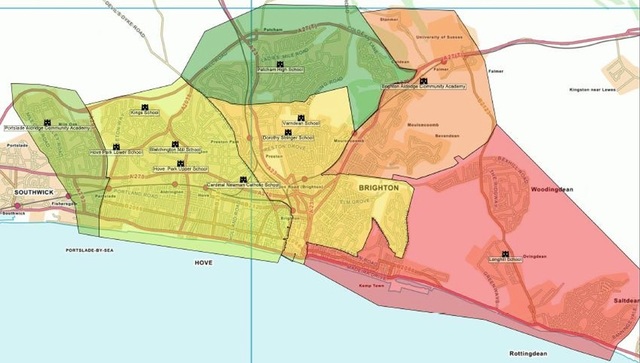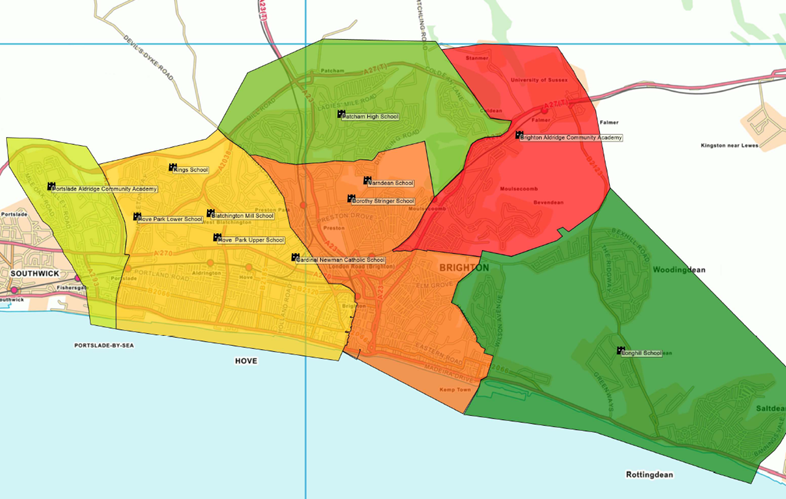A catchment area change could mean that dozens more children from Whitehawk go to secondary school at Varndean and Dorothy Stringer instead of Longhill.
And a similar number of children from Kemp Town would be more likely to be allocated a place at Longhill rather than Stringer or Varndean.
Other changes would give more children who qualify for free school meals a higher chance of going to their first choice secondary school even if it is outside their catchment area.
And children who are currently in the BACA, PACA, Patcham High and Longhill catchments would have a better chance of going to a school such as Blatchington Mill, Stringer or Varndean.
The proposed changes to secondary school catchments – along with plans to cut intake numbers – are due before the council’s cabinet next week.
Senior councillors are expected to agree that Brighton and Hove City Council should carry out a formal consultation on the proposals next month and in January.
The proposals include cutting the published admission number (PAN) at three schools – Blatchington Mill, Dorothy Stringer and Longhill – because of the forecast increase in spare classroom places across Brighton and Hove.
If the changes are approved, parents and pupils would be able to select their first four preferences rather than three.
And a report to the cabinet said that the proposed changes affecting Whitehawk and Kemp Town made use of existing bus routes and services at a time when car trips to school are up.
The proposals would move children with a BN2 5 postcode north of Manor Way and Manor Hill out of the Longhill catchment and into the Dorothy Stringer and Varndean catchment.
Meanwhile, children living in BN2 1 and BN2 5 south of Manor Way and Manor Hill would move out of the Stringer and Varndean catchment and into the Longhill catchment.
The report to the council’s cabinet said that the proposal was intended “to address education disadvantage in one distinct area of the city”.
It said: “This proposed change seeks to address some of the systemic inequality that can be compounded by the boundaries of a school’s catchment area.”
The proposals would reduce year 7 intakes in September 2026 at three schools
• Longhill – down from 270 to 210 pupils
• Blatchington Mill – down from 330 to 300 pupils
• Dorothy Stringer – down from 330 to 300 pupils

The report said: “The proposal around catchment areas seeks to take advantage of the existing transport routes.
“Due to the location of the city’s schools, the Whitehawk and Kemp Town areas require pupils to use transport to travel to all three receiving schools.
“As such, in either the existing catchment model or the proposed future model, it is unlikely that pupils in either area would be walking to school.”
The proposed changes are described in the report as delivering a “comprehensive” offer to improve outcomes for disadvantaged pupils.
The report comes after a public engagement exercise carried out last month. It received more than 2,400 responses and attracted criticism, in particular, from people in the Dorothy Stringer and Varndean catchments.
Some were concerned that children living close to Stringer and Varndean would face long journeys to and from school.
As a result of negative feedback, none of the three catchment proposals in the public engagement exercise have been retained.

The report said: “The proposal avoids large catchment areas which could introduce significant levels of cross-city journeys, recognises the practicality of proximity to a school site and approaches the issue of greater access with a proposed new admission priority.
“The council continues to propose a reduction in PAN of some schools because of the direct need to reflect the reduction in pupil numbers forecast in future years and thereby addressing one of the stated ambitions to maintain all the current 10 school sites in the city.”
The council has been trying to reduce primary school intakes since 2019 to reflect the falling number of children in Brighton and Hove.
But the cabinet report includes a proposal to consult on an increase to the intake at Rudyard Kipling Primary School, in Woodingdean, from 30 to 45.
School budgets are mainly funded by the government and based on pupil numbers. The report said: “The proposal to decrease the PAN across a number of schools is intended to reduce the number of surplus school places to safeguard and benefit the wider provision across the city.
“By reducing the number of surplus places in the city in the longer term, there is an expectation that school occupancy rates will increase meaning that school budgets are more sustainable.”
Subject to cabinet approval, the consultation would run on the Your Voice section of the council’s website for eight weeks from Friday 6 December to Friday 31 January.
The council is planning to hold a number of public meetings online and in person
• Monday 9 December from 6pm to 7.30pm online
• Thursday 12 December from 10am to 11.30am online
• Tuesday 7 January from 6pm to 7.30pm in person at Hove Town Hall – to be confirmed (TBC)
• Saturday 11 January from 10.30am to noon in person at the Jubilee Library – TBC
Further meetings may be scheduled after the consultation starts, should the cabinet agree.
The cabinet is due to meet at Hove Town Hall at 5pm on Thursday 5 December. The meeting is scheduled to be webcast on the council’s website.









So essentially the proposal is the option b that the majority were very critical of just written in bullet points of prioritt rather than catchment zones.
That will go down well…
In fact…its worse than option b which is some achievement!
Catchment area seems like is a ploy, it is proposed to be number 6 on the list of child prioritisation, so living in a catchment area will give little benefit, it all seems to be about bussing hoards of kids who live near Varndean and Dorothy Stringer to Longhill to try and save it.
Academia suggests that mixing socioeconomics is beneficial. Moreover, if you argue that diversifying schools protects them from facing a lack of students and helps maintain their financial viability, then the sentiment of ensuring schools remain open—something you have also expressed a desire for—is a positive one.
This is crazy. The problem is: east Brighton kids have to travel far to get to school, the school they go to has bad reputation. Solution: put central Brighton kids in a school that is far for them and has bad reputation. Solve problem here, to create another one there. Who came up with this?
Equality of Educational Opportunity report, known as the Coleman Report, in 1966. James Coleman and his colleagues identified that the socioeconomic composition of a school had a significant impact on student outcomes.
Later, scholars like Richard D. Kahlenberg expanded on Coleman’s findings, advocating for socioeconomic integration as a more practical and politically viable approach to achieving equality in education. Kahlenberg’s work in the 1990s and 2000s has been particularly influential in framing policy discussions on this topic. His research, alongside others like Ann Mantil and Sean Reardon, continues to underscore the academic and social benefits of diverse school environments for all students.
Makes a complete nonsense of the ‘School Streets’ initiative recently implemented at Dorothy Stringer & Varndean to get kids walking to school …
Surely standards should be improved at Longhill so students don’t have to criss cross the city
This, I also agree with. Although not the entire picture, you have to consider the advantages and disadvantages of the different socioeconomic classes, requiring a different approach to education.
Imagine two schools: one primarily attended by students from high-income families and another by students from low-income families. The high-income school benefits from well-funded extracurricular activities and advanced facilities, but students might lack exposure to diverse life experiences, potentially limiting empathy and social awareness. Conversely, low-income schools may foster resilience and creativity in overcoming challenges but might struggle with resources and opportunities for academic advancement.
By integrating students from both socioeconomic groups, the schools can offer a richer learning environment. High-income students gain broader perspectives, while low-income students access better resources and opportunities. There is homogenisation.
I’m all up for Children in Whitehawk to go to Other Secondary Schools, my two boys went to Longhill and only left there in May this year, but he and his Brother were gutted they didn’t get Stringer or Varndean like there Friends did, as they went to Queens park Primary and that’s there Catchment of Schools-just wish I lied like a lot did-but my Partner was like don’t lie we will get caught-but I’m sure Coumcil don’t check Address it’s the Postcode they go by.
And I can’t believe they are cutting Numbers as of Sept 2026, longhill isn’t over subscribed like others are-so taking them from 270 to 210 ( per year is this) that’s not a lot of Children
And Blatchington Mill & Stringer to go from 330 to 300 aswell.
Good Luck anyway to those that apply for 2025/6
Regrettably, the quality of a school is often down to the education and resources of the parents as much as the teaching staff. If you artificially introduce children into Varndean and Stringer from families where education is not valued and generational unemployment is the norm then the quality of the educational experience will decline.
I can’t say I agree with this, having come from an area that lacked funding and quality schools. You can’t just funnel resources to Middle Class kids. That’s what creates the mainly inadequate hordes of Middle Class Councillors and MP’s who believe it’s their god given right to rule over us. Maybe try and spend a little time in the areas you are talking about. You’ll see kids with as much ambition and knowledge as those in more affluent areas. Giving them an equal opportunity is something we should all strive to do.
Quite significant and long-standing, peer-reviewed research suggests the opposite, fortunately, when it comes to mixing groups.
However, education quality does indeed start at home. Whilst this might be arguably out of remit for schools, exploring what can be done to enhance and support extracurricular activities, say through the local community centres, like The Crew Club in Whitehawk, may be a way forward.
Rudyard Kipling Primary School and Nursery is not in Rottingdean, it’s in Woodingdean
Thank you. That’s been corrected.